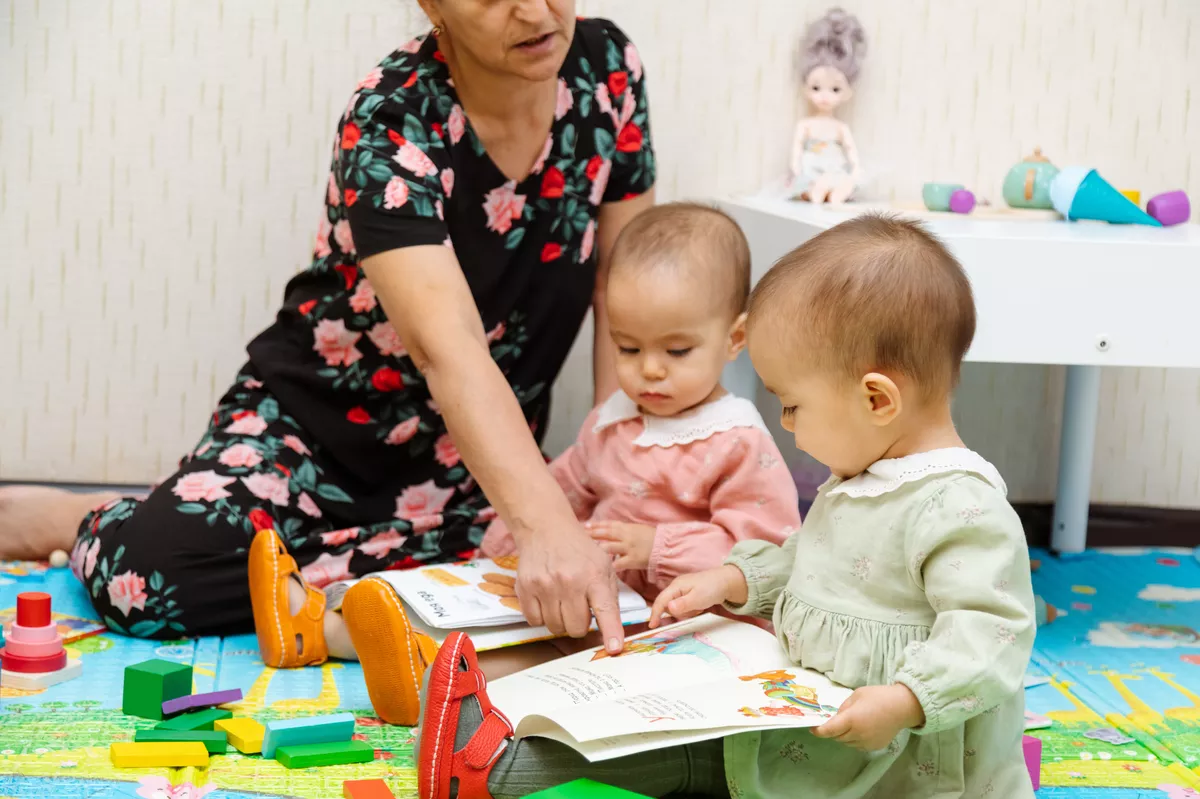👋 Welcome to Starting Early. Every other week, we spotlight new reports, useful news, engaging interviews with people doing important work, and interesting takes on maternal health and early childhood development issues.
An important part of the US child care system especially hard hit by the pandemic and too often overlooked in the effort to help families balance work and caregiving is family child care – also known as home-based care. Family child care – which usually takes place in providers’ homes – often costs less than care provided at freestanding centers. And it’s more likely to lack the financial and operational support needed to compete. As a result, many family care providers have gone out of business – further worsening the plight of families that have trouble finding high-quality, affordable care.
In this issue of Starting Early, we examine the situation and share encouraging examples of innovative action to help family care providers.
Read on and click the links to go deeper.
1 big thing: Why family child care is so valuable

Many families rely on the small-group, close-knit environments that home-based providers offer. Matline, a Florida-based family child care provider explains that parents are “comfortable leaving their children with someone that cares and nurtures their children as they would in their home. Family child care homes are considered ‘a home away from home.’”
Nationwide, about 1 million paid, home-based providers – 118,000 of whom are licensed or regulated – provide child care to over 3 million children under 5.
Longer hours: Family child care homes often open earlier in the day than center-based care and close later. This helps people with non-standard and less flexible work hours – an equity-promoting boost for families that struggle to make ends meet.
Cultural congruency: Families may prefer family child care homes that have a shared racial, cultural, or linguistic background that offers continuity between a child’s home and child care setting.
“Every community has different nationalities, different standards, different necessities. I felt we can make a difference. Children don’t have to know the English language right now, but they can learn it at their own pace, and be comfortable.” – Nancy Jimenez, award-winning New Jersey-based family child care provider
Lower cost: Family child care is an affordable option for families less likely to use center-based care than those with higher incomes. On average, family child care costs $8,000 a year for children under 4, compared to $10,000 for center-based care.
And that’s not all: Other benefits of family child care often include:
- Smaller group sizes, enabling closer supervision
- Mixed-age groups, where siblings can be cared for by the same provider
- Child care options closer to families’ homes, which especially helps rural families
But family child care providers struggle: They have less access than center-based providers to governmental funding and earn less on average. A third of family child care providers report facing at least one material hardship, threatening providers’ emotional wellbeing and contributing to burnout.
The bottom line: In an under-resourced child care system, family child care providers receive an even smaller piece of the pie – forcing many out of business and limiting families’ child care options.
- By the numbers: More than 90,000 licensed family child care homes closed in the US from 2005 to 2017.
- And the pandemic made it worse: Nearly 7,000 licensed family child care homes closed from December 2019 to March 2021.
“When our public policies support a robust, mixed-delivery child care sector that fully includes family child care, parents can go to work with peace of mind, children are safe and learning, and the economy benefits from a reliable workforce, increased tax revenue, and decreased reliance on public assistance.” – Dana Holahan and Erica Williamson Phillips in Exchange Press.
2. New ideas offer hope
Nonprofits across the US are pursuing innovative strategies to better support family child care providers. Here are 4 promising examples:
- Providing ongoing support: Through its staffed family child care network, All Our Kin – a national nonprofit that trains, supports, and sustains family care educators – offers mentorship, professional development, and community. Consultants visit family child care homes to provide resources and strategies promoting early learning and healthy development. The organization also offers operational support through zero-interest loans, grants, financial management, and other services.
- By the numbers: All Our Kin trains and supports nearly 1,100 family child care providers, who serve more than 6,000 children.
To address systems-level barriers, All Our Kin advises state and local leaders on policies and strategies to strengthen family child care providers.
- The power of networks: A national collaborative, Home Grown supports providers in 30 states by building home-based child care networks.
- Because home-based care providers are more isolated, disconnected, and diffused, Executive Director Natalie Renew explains, “We view networks as infrastructure.”
Home Grown promotes grassroots leadership through Leading From Home with monthly stipends to help provider leaders create local peer-to-peer groups and free technical assistance.
Aiming to boost the economic stability of home-based providers, the Thriving Providers Project gives cash payments to providers for at least a year as well as peer and professional support.
- The power of tech: Wonderschool’s child care management platform offers new and experienced home-based child care providers tools and resources to make their business sustainable. Providers get help with marketing, billing, licensing, and other needs – and they can connect with advisors and peers to problem-solve, receive mentorship, and share resources.
Wonderschool also partners with state and local governments, child care resource and referral networks, and community organizations. It operates statewide in New Mexico, Indiana, Nevada, and North Carolina.
- Linking family-based care with centers: A 4-year pilot program led by United Way of Northern New Jersey, United in Care connects highly-rated child care centers with family child care providers. Each child care center provides administrative and financial support, training, backup staff, and other resources for 5 to 10 local family child care providers. Through the United in Care Academy, providers receive professional development opportunities to hone their operational, marketing, and early childhood skills.
The pilot serves 6 New Jersey counties identified as child care deserts – where there are too few licensed child care slots to serve the number of children in the area. To date, the program has served 4 child care centers, 23 family child care providers, and 511 children.
3. State policy efforts support family child care providers

Recognizing the need for family child care as an option, some states are looking for ways to remove barriers to sustainability. Here are some policy changes leading the way:
California: As businesses operating out of residences, family child care providers can face challenges with local zoning ordinances and restrictions from landlords and homeowner associations.
In response, Gov. Gavin Newsome signed the Keeping Kids Close to Home Act in 2019, barring city or county governments from requiring a zoning permit or business license for family child care homes. The act also prevents landlords from refusing to rent to providers or trying to evict them for running a child care home. Prior to the act, some providers paid up to $10,000 for a zoning permit and to meet related requirements.
Washington, DC: Low pay makes it hard for many child care workers to afford insurance and other necessities. In 2019, 8.1% of licensed and 16.5% of unlisted home-based providers were uninsured nationwide.
This year, DC started making free or low-premium health insurance available to early childhood education professionals, including family child care providers and center-based teachers, through HealthCare4ChildCare. DC-based workers and their families can enroll in a health plan for free, regardless of citizenship status. Early childhood workers employed in Washington and living elsewhere can enroll for free or at a lower premium.
The District also launched the Early Childhood Educator Pay Equity Fund, through which eligible workers can receive a pay supplement of up to $14,000.
Kentucky: Some child care workers can’t afford child care for their own kids so the state offers subsidies to all licensed and certified family child care providers and center-based teachers who work at least 20 hours a week. The employees are recognized as a protected population, qualifying for subsidies regardless of their income.
🎩Hat tip to Natalie Renew for sharing her knowledge of state policy actions.
4. The roundup
Learn about upcoming events, new funding opportunities, and jobs in maternal and infant health and early childhood:
- Save the date: The National Association for Family Child Care’s Annual Conference will be held in Atlanta, July 12-15. Register here to attend.
- Transforming healthcare: The Burke Foundation and our partners at the New Jersey Chapter, American Academy of Pediatrics are expanding the Centering model across New Jersey. The group-based healthcare model serves pregnant women (CenteringPregnancy) and parents of young children (CenteringParenting). To learn more and receive updates, sign up for NJAAP’s monthly newsletter, At the Center.
- Summer child care: A useful article in The Atlantic details the struggles families face finding summer child care and the reliance on summer camps for those who can afford it.
- From data to action: Advocates for Children of New Jersey is hosting community conversations to review data from Trenton Kids Count 2023 and brainstorm solutions serving the needs of Trenton children. The first community conversation is February 15 and will focus on education and development. Click here to view the report and register to attend a community conversation.
